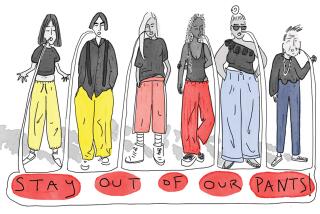A Brief History of Shaping Women
- Share via
As women everywhere stand poised to enter a new millennium, it is a fitting time to look back on what the last 100 years have revealed about our bodies and ourselves. Lingerie reveals some of history’s ups and downs, charting women’s progressive emancipation, the impact of the two world wars, the Depression and the sexual revolution, according to Karen W. Bressler, who co-authored “A Century of Lingerie” (Quarto, 1997) with Karoline Newman and Gillian Proctor. “In each decade you see lingerie reflecting how women are evolving,” Bressler says.
At the beginning of the 20th century, women’s underpinnings, like their lives, were restrictive. Petticoats and corsets accentuated the fashionable S-shaped silhouette of the day.
“Lingerie was personal. No one saw it, yet a woman spent a fifth of her allowance on undergarments and hours putting on all the pieces,” Bressler explains.
But it was also in the early 1900s that the women’s suffrage movement began to loosen society’s grip on the female form. The book cites World War I as the “death knell of the corset.” Women required physical freedom to carry out wartime work. Stockings became popular as skirt lengths rose and an early form of rayon became available.
The postwar 1920s was a decade of excess that saw the popularization of bras. The first were designed to shape a flapper’s body by flattening the bust and pushing it downward. In 1925, the Kestos Co. marketed the first shaped bra. It was made of two triangular pieces of fabric secured to elastic that pulled over the shoulders, crossed at the back and buttoned at the front under darted cups, according to “Let There Be Clothes: 40,000 Years of Fashion” (Workman, 1991).
The party came to an end in 1929 with the stock market crash. People escaped their woes by going to the movies, which is when Hollywood began influencing everyday clothing. Fashion was dominated by studio designers like Adrian and Madame Gres, whose long, sensuous dress lines in slinky fabrics brought the bust back.
As the world went to war for the second time in 1938, rationing took hold.
“Women didn’t have enough money for stockings, so they dyed their legs with coffee and drew seams with an eyebrow pencil,” Bressler says.
Masculine, uniform-like fashions were abandoned at the end of the 1940s when Christian Dior’s New Look was born.
Petticoats danced into the 1950s under the poodle skirts of the rock ‘n’ roll generation, and Hollywood continued to exert its influence. Buxom actress Jane Russell wore the famous cantilever bra designed by aeronautical engineer Howard Hughes in the film, “The Outlaw.” The 1960s and ‘70s heralded the feminist movement and the sexual revolution. Younger women began wearing less-structured bras, going braless--or burning their bras as a symbol of liberation.
High-fashion designers like Jean Paul Gaultier and John Galliano picked up on the punk ideas of the 1970s, creating entire collections around severe corsets and pointy bustiers in the 1980s.
In the 1990s, the choices for women--and lingerie--are limitless. Victoria’s Secret has made sexy underwear accessible. At the same time, sporty briefs, boxers, thongs and bikinis are produced.
Bressler believes the future of women’s lingerie lies in new fabrics.
“Spas often offer paper underwear,” she says. “The best pair I have found is one-size-fits-all and has an elastic waist. This is a hint of the lingerie to come in the next century.”







